Abstract
Seagrass beds are considered important feeding places for a variety of fish species characterized with complex trophic interactions. In this paper we described the trophic network of a fish community inhabiting a seagrass bed in the Venezuelan Caribbean. In addition, a consumption index (CI) for each prey ingested is proposed using two variables: abundance and consumption frequency. Eight samplings (at four time intervals: 6:00, 12:00, 18:00 and 24:00 hours) were done in August 2005 and January 2006. Fifty one fish species in 29 families were captured; Haemulidae was the most abundant. Crustacea was the most important food resource of the 28 food items identified. The relative importance of trophic guilds, considering abundance and taxonomic species richness, was: benthophagous>herbivorous>piscivorous. The features of the trophic network were: 1) high proportion of short chains (two links), 2) high number of intermediate species, 3) high consumption of benthos, 4) low CI values and 5) few species with a high number of linkages. Temporal (hourly and monthly) differences were obtained in fish species number (total, intermediate and top), total linkages, connectivity and maximal chain lengths. The connectance did not show significant temporal variation and it was similar to other environments with different species richness. In contrast, the connectivity was lower than the one reported for environments with low species richness. As in other reports, the temporal variationof the trophic parameters and the community structure was different. The values of CI for the different preys were low except for harpacticoid copepods and crustacean larvaes. The cluster value of CI was high for benthos (>80 %) and, in general, low for plankton and nekton preys. The seagrass bed studied was an important feeding place where the configuration of trophic network changed in different temporal scales and reflected the dynamic of the feeding relationships this fish community.
##plugins.facebook.comentarios##

This work is licensed under a Creative Commons Attribution 4.0 International License.
Copyright (c) 2009 Revista de Biología Tropical






